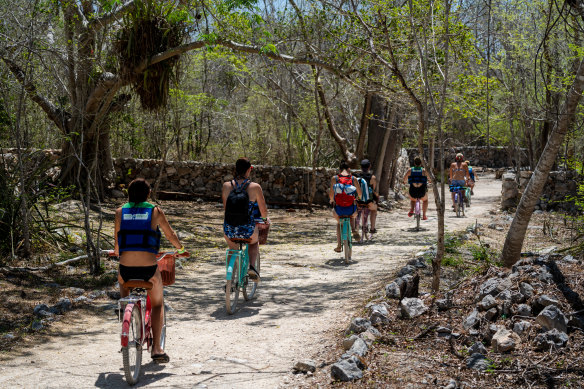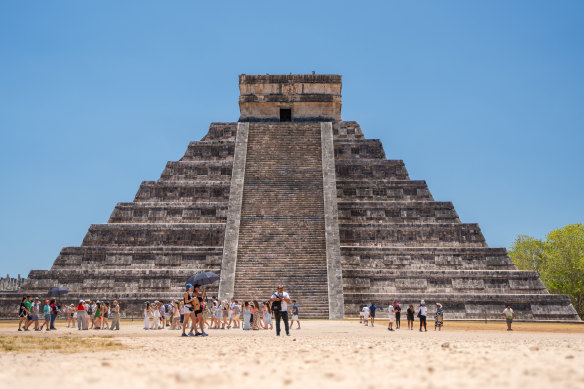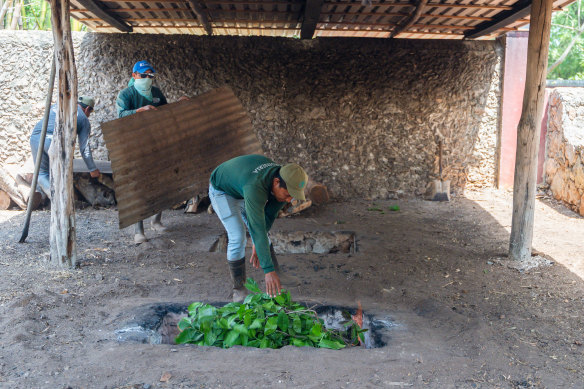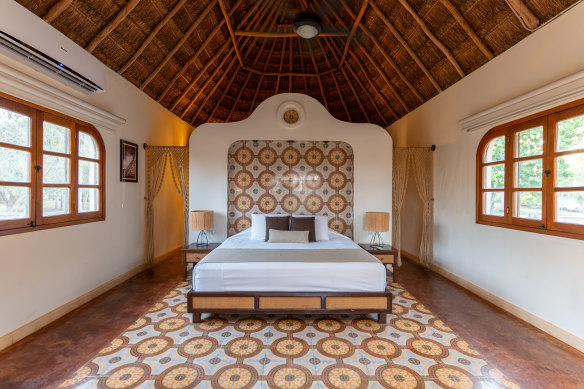On a trip packed with mind-blowing experiences, one is priceless
By Carolyn Beasley
“For the Maya, there were 13 gods in the celestial level and nine gods in the underworld, and those can be vicious,” says Ricardo Fernandez, our local guide. Like the ancient Maya people themselves, the gods of the underworld play the ball game called pok-ta-pok. “But they don’t play with rubber balls,” Ricardo says, eyes widening. “They play with skulls.”
Ricardo’s burning incense wafts through the circular limestone cavern, cleansing the air of vicious spirits, before drifting skywards, past the sacred ficus tree that clings to the cliff, its branches reaching for the celestial realm, while its roots stretch down to tap the waters of this portal to the underworld.

Yucatan cenotes are a sublime place for a dip.
We’re seated on the edge of Xooch cenote, a circular sinkhole created by collapsing limestone. It’s one of about 6000 cenotes on Mexico’s Yucatan Peninsula. The cenotes connect to underground rivers, and their iridescent turquoise waters make a sublime place for a dip.
Here at Santa Barbara, my tour group is cycling between four adjacent cenotes, pedalling in wet bathers in warm sunshine, before diving into the next.

Cycling between cenotes.
Active exploration like this is typical of my G Adventures tour. The tour explores the cenotes and Maya culture of the Yucatan and is part of the company’s newest tour style, The Geluxe Collection, which offers tours in 26 countries.
Geluxe tours have a maximum of 16 and an average of 12 participants and are likely to attract more mature, active travellers. Private transport for each group is guaranteed, as is comfortable accommodation that may be booked on a solo basis.

First stop is the sacred Maya pyramid of Chichen Itza.
My eight-day tour starts in Playa del Carmen and finishes in Tulum, and both cities are near airports. On night one, our group meets for cocktails and dinner with our full-time guide, Lola Biscaye. Residing in Mexico and with a degree in anthropology, Lola has an energy and knowledge that befits the job.
The tour style promises a slower pace and cultural experiences, and this tour certainly delivers. Our first stop is the sacred Maya pyramid of Chichen Itza, where we meet guide Alfredo Mendez. Alfredo explains theories around Maya civilisation’s rise and decline, and the mysterious snake shadow that appears on the pyramid in the autumn and spring equinox. Alfredo walks us through the stone pok-ta-pok stadium, and the carved story scenes depicting one captain losing his head.
At lunch, we eschew the mass-tourist restaurants and contrived performances, instead pulling up to a village house. G Adventures supports many small-scale local businesses and helped Claudia and Beto Noh Balam set up an in-home restaurant.
In their dining room, we feast on delicious cochinita pibil (slow-roasted pork), refried beans, guacamole and salsas. With Lola translating, Claudia tells me the company has changed her life.

The Sian Ka’an biosphere near Tulum is a place of extraordinary natural and cultural values.
“My husband and I were working every day, 16-hour days, sometimes more because we’re working in the kitchens and seeing very little income,” Claudia says. “We make enough money now that our children can continue their studies, and perhaps even go to university.”
For me, this connection with local people is priceless, a lasting travel memory.
The company seeks to tread lightly on the planet, too. Avoiding single-use plastic bottles and their impact on communities, Lola always finds ways for us to safely fill our reusable drink bottles, often from a restaurant’s large dispenser. A bulk dispenser even travels with us in the bus.
None of this responsible travel comes at the expense of fun, and on each Geluxe tour, there’s an “OMG day” where guests choose their own adventure. On our tour, one group visits the less-touristy Maya ruins of Uxmal while mine joins a mangrove kayak in the Ria Celestun Biosphere Reserve.
Gliding through a mangrove tunnel past a city of aerial roots, guide Alexander Cruz casually whispers that there’s a crocodile ahead. I anticipate something small, but suddenly I’m facing a 2.5-metre Morelet’s crocodile with two babies. Alexander says that in all his experience, they are not dangerous. After our paddle, we laugh as we discover Alexander is a mere 17 years old. His experience with crocodiles is not particularly extensive.
Alexander shows us the community rehabilitation project that is repairing mangroves obliterated in 1988 by Hurricane Gilbert. There’s a petrified forest, where salty water has preserved the dead trees and a pink lake filled with shrimp that give colour to flamingos that visit here seasonally.
But the mangroves are supporting more than just birds and fish. Small-scale mangrove ecotourism, and visitors like us, provide career options for people like Alexander.
“That’s why I really appreciate this place,” Alexander says, as we pile into a fleet of waiting tuk-tuks to return to our bus. “It’s where I started to learn English, and now I’m going for French. It’s very comfortable to be a local guide.”
Each tour also features an “OMG stay”, and ours is the Hacienda Sotuta de Peon, near Merida. We’re accommodated in modern bungalows featuring traditional tiles, a soaring thatched roof and private plunge pool – all in an agave plantation dating to 1858.

Cooking cochinita pibil (slow-roasted pork) underground at Hacienda Sotuta de Peon.
There are cultural lessons here, and some are not pretty. Ivan Fuentes guides us through hacienda history, explaining that initially, haciendas were cattle ranches. Agave plants became more lucrative, with the fibres called sisal woven primarily for rope for the shipping industry. The industry prospered through indescribable cruelty and slavery.
Today we’re seated on the deck of a mule-drawn carriage that runs along train tracks, the original sisal transport. Our destination is the property’s private cenote, where we descend steps into an underground cavern for a surreal swimming experience. Emerging from the cenote, we find mezcal margaritas, made from agave and served from an old hacienda carriage.
Aside from sunset tipples for travellers, there are other benefits to this hacienda. In the surrounding village of 300 people, jobs are scarce and many live in tough conditions.
“About 70 per cent of the men had migrated to find work in Cancun,” Ivan says. “When this place opened for tourism, many of those men were able to return. So it created a reunion.”

A spider monkey in Sian Ka’an Biosphere Reserve.Credit: iStockphoto
Our cultural exploration continues at the hacienda by diving into the Yucatan food scene. Accepting the offer to help, I’m soon up to my wrists in a vibrant red marinade of achiote (annatto seeds) and bitter orange, coating 40 kilograms of pork slabs to prepare cochinita pibil. The pork is wrapped in banana leaves and placed in a metal box. It’s then lowered into an outdoor pit, smouldering with red-hot coals, before more coals and oak leaves are loaded on top.
Perhaps even more culturally significant are the ubiquitous corn tortillas. Back at Xooch cenote, guide Ricardo had explained that corn is sacred and has a god.
“The first Maya man and woman were created when the god blew on the corn dough and turned it into people,” Ricardo said.
We watch as Maria, the specialist tortilla cook, rolls the circular tortillas from a bowl of fresh corn dough, tossing them on a giant hot plate. Their taste is incomparable to what we buy as tortillas in Australian supermarkets, and when served with the eight-hour roasted cochinita pibil, plus pickled onions, guacamole and punchy habanero salsa, it’s a meal fit for a king, or hacienda boss.
On our final day, we’re touring the Sian Ka’an biosphere near Tulum, a place of extraordinary natural and cultural values. Our ecotourism guide, Gilberto Che, works for a collective of 20 Maya families, the traditional owners of this place.
“Their grandparents were living here, hunting fish and animals in the jungle,” he says. “They had a tree log for a boat, a pole and a paddle.”
Although we’re in a faster vessel, our motorboat is soon following in the Maya’s canoe wake, crossing the turquoise Muyil Lagoon before entering a narrow mangrove-lined canal.
“This canal was cut centuries ago by the Maya – it’s a shortcut trading route to the sea,” Gilberto says.

Hacienda de Sotuta de Peon offers a restful stay.
The canal opens out to the vast Chunyaxche Lagoon, and we skim across to a second canal. This one extends for kilometres to the sea, but we’re exploring the first kilometre using a different method. Leaving the boat, I’m stepping through the armholes of an upside-down lifejacket and into the canal itself.
Drifting with the current in an oversized nappy is new for me, but this trip has delivered many mind-blowing experiences that would be difficult to achieve independently. Along the way, we’ve benefited not only ourselves, but the communities we’ve visited. I gaze up at the cobalt Mexican sky, floating slowly through Maya history.
The writer travelled as a guest of G Adventures.
The details
Tour
Mexico’s Yucatan Peninsula, Mayan Ruins and Cenotes is an eight-day tour from Playa del Carmen to Tulum. From $4289 a person twin share, including all accommodation and activities, seven breakfasts, six lunches and five dinners. See Gadventures.com
Fly
To start the tour, fly from Brisbane, Sydney or Melbourne to Cancun, Mexico, stopping in the US, usually at Dallas Fort Worth (Qantas and American Airlines) or LA (United Airlines). After the tour, return to Cancun (about 1.5 hours in a private taxi) to fly out or depart from Tulum Airport via Houston, LA or San Francisco with United Airlines, Qantas and Alaska Airlines.
Sign up for the Traveller Deals newsletter
Get exclusive travel deals delivered straight to your inbox. Sign up now.